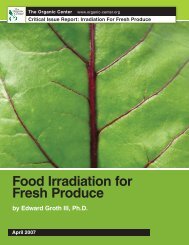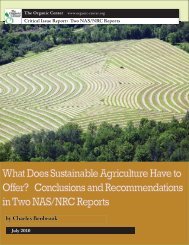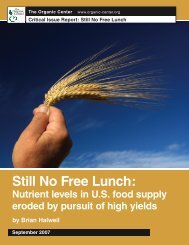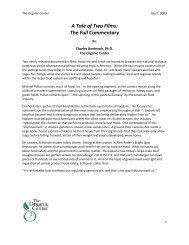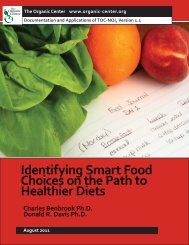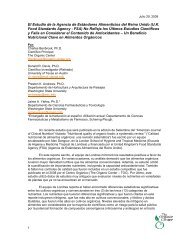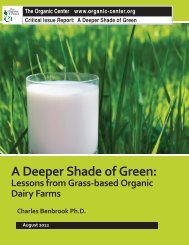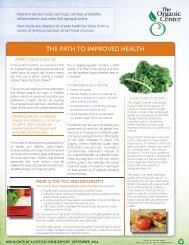Organoleptic Quality? - The Organic Center
Organoleptic Quality? - The Organic Center
Organoleptic Quality? - The Organic Center
You also want an ePaper? Increase the reach of your titles
YUMPU automatically turns print PDFs into web optimized ePapers that Google loves.
Taste of <strong>Organic</strong> Food <strong>The</strong> <strong>Organic</strong> <strong>Center</strong><br />
design (Reganold et al., 2001).<br />
Peck studied Gala apples grown during the ninth and<br />
tenth growing seasons under organic, integrated, or<br />
conventional management in the Yakima Valley of<br />
Washington State (Peck, 2004). <strong>Organic</strong> apples had 6-<br />
10 Newtons (a Newton -- “N” -- is a measure of force)<br />
units higher flesh firmness than conventional apples,<br />
and 4-7 N units higher firmness than integrated<br />
apples. Additionally, consumers consistently rated<br />
organic apples to be firmer and to have better<br />
textural properties. Few consistent results were<br />
found for fruit flavor as measured by soluble solids<br />
concentration or titratable acidity, and this was also<br />
reflected in consumer panels. <strong>The</strong>se Gala apples<br />
were slightly smaller in some years but were as firm,<br />
or firmer, and had consistently superior storability<br />
compared to conventionally grown apples (Peck et<br />
al., 2006). After six months of controlled atmosphere<br />
storage, only 10% of the organic apples failed to<br />
meet the minimum firmness standard, compared to<br />
36% of conventional management apples and 54% of<br />
integrated management apples.<br />
Bordeleau et al. compared specific internal and<br />
external quality parameters for organic and<br />
conventional Golden Delicious apples purchased<br />
in shops in Denmark (Bordeleau et al., 2002). <strong>The</strong><br />
conventional apples were 24% bigger, averaging<br />
156.5 mL in volume compared to 126.7 mL for the<br />
organic apples. Soluble solids (sugars, Brix) and acid<br />
levels did not differ significantly but the ratio of Brix<br />
to acid was slightly higher in the organic apples.<br />
<strong>The</strong>re was no difference in<br />
flesh firmness in this market<br />
survey.<br />
Strawberries<br />
Ecologically cultivated<br />
strawberries and<br />
conventionally cultivated strawberries were grown in<br />
adjacent plots in Spain under identical environmental<br />
conditions (Cayuela et al., 1997). <strong>The</strong> conventional<br />
plots had a 76% greater yield. <strong>The</strong> ecologically grown<br />
fruit had superior quality to the conventionally grown<br />
fruit, showing a more intense color, higher sugar<br />
and dry matter contents, and better organoleptic<br />
characteristics. Ecologically grown fruits had a<br />
higher resistance to deterioration during simulated<br />
marketing conditions, and thus better keeping quality.<br />
<strong>Organic</strong> strawberries grown in California were slightly<br />
smaller but sweeter, better-looking, and preferred<br />
by consumers compared to conventionally grown<br />
strawberries (Andrews and Reganold, 2006).<br />
Potatoes<br />
Potatoes were among the earliest organically<br />
produced vegetables subjected to comparative<br />
evaluation. Of 22 published studies that evaluated the<br />
nutritional value and/or sensory properties of potatoes<br />
from conventional and organic cultivation, or from<br />
different fertilization systems, only six compared the<br />
sensory qualities of potatoes using trained panelists.<br />
Some sensory differences were noted between<br />
different kinds of potatoes but no clear statements<br />
could be made on the whole in favor of one kind of<br />
cultivation or another (Woese et al., 1997).<br />
Heaton (2001) considered three of these publications<br />
to be “invalid agriculturally” because the results were<br />
obtained with “organic” potatoes grown on soil with<br />
less than three years of organic cultivation (Dlouhy,<br />
1977; Pettersson,<br />
1977;<br />
Pettersson,<br />
1978; Svec et<br />
al., 1976). He<br />
considered the<br />
second report of<br />
Dlouhy (Dlouhy,<br />
1981) to be<br />
“agriculturally<br />
valid”; Dlouhy<br />
(Dlouhy, 1981)<br />
reported better<br />
taste in organically<br />
grown peeled potatoes after four months of storage.<br />
Heaton did not critique all six studies evaluated by<br />
Woese et al. (1997).<br />
<strong>The</strong> most recently published comparative sensory<br />
testing of organic and conventional potatoes does<br />
not improve our understanding of the relative taste<br />
of organic potatoes. In research at Ohio State<br />
University, triangle tests were used to determine if<br />
taste panelists could distinguish cooked wedges of<br />
potatoes grown organically, either with or without<br />
compost, and conventionally (Wszelaki et al., 2005).<br />
When the skin remained on the potatoes, panelists<br />
detected differences between conventional potatoes<br />
and organic potatoes, regardless of soil treatment.<br />
However, they did not distinguish between organic<br />
treatments with or without compost when samples<br />
contained skin, or between any treatments if wedges<br />
were peeled prior to preparation and presentation.<br />
Tomatoes<br />
<strong>Organic</strong> and conventional tomatoes grown in Florida<br />
in December 2003 and January 2005 were harvested<br />
at the breaker stage and ripened at 20ºC. When




